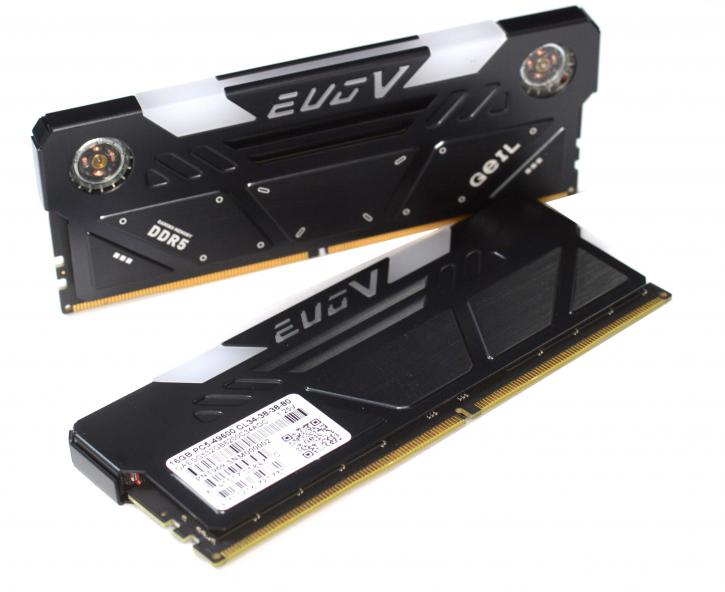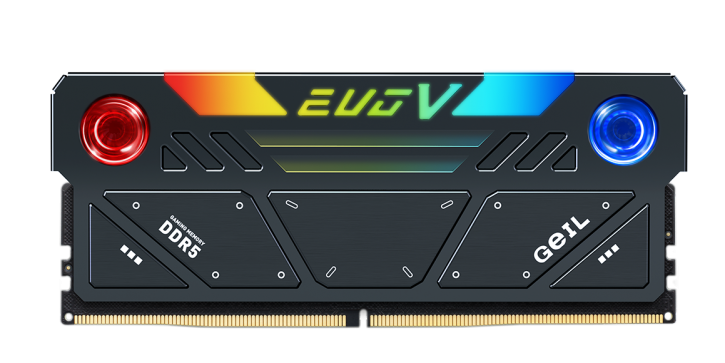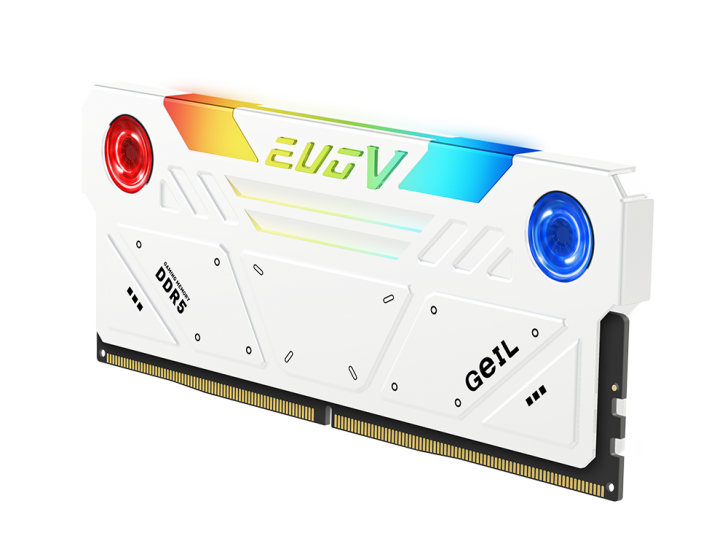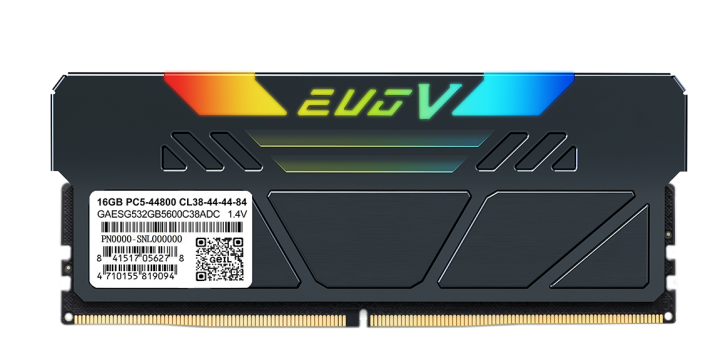Introduction
Geil EvoV 6200 CL36 DDR5 6200 MHz CL34 32 GB (2x 16 GB)
In May, Geil presented a new series of DDR5 memories: the EvoV. The available kits have a frequency ranging from the base 4800 MHz up to 6800 MHz (and up to 6400 MHz for the AMD platform). We are checking the Geil EvoV RGB 6200 MHz CL34 DDR5 kit today with the AMD EXPO profile. The main thing that makes the Evo V stand out is the built-in fans (in the radiator). They’re rotating at about 12000 rpm, +/- 20% (but please remember they are small, with a 2 cm diameter, so the revs shouldn’t be so scary). The acoustic noise is 19.37 dBA average and 22.37 dBA maximum, both taken from 1 meter. The fan life expectancy is 40K hours@25 degrees Celsius, and the humidity is between 15 and 65%. A Polaris series (without the mentioned fans feature) is also available in the Geil offer, both in the RGB and non-RGB versions and with and without the AMD profile. As for the reviewed Evo V kit - it’s more or less in the middle frequency in the series. As I’ve checked, the last time we had an opportunity to inspect the Geil memories was in the DDR1 times (yikes!), and it was awarded the “Editor’s Choice” by Hilbert. The Geil song was already made in 1986 (just joking)
Geil in the Netherlands means “horny,” but in Germany, it’s “awesome”/”cool,” so we’d rather stay with the second meaning. The Geil stands for Golden Emperor International Limited; the headquarters are in Taipei, Taiwan. It was founded in 1993, so it’ll have its 30th anniversary next year.
A quick reminder - DDR5 is the newest technology to hit the market, make headlines, and break world records. DDR5 already set spectacular results in overclocking (of course, using the LN2), as even 10550 MHz. DDR4 RAMs operate on a single 64-bit bus, while DDR5 has two 32-bit buses (plus, in both cases, an additional 8-bit for ECC). As a result, a single module is identified as Dual Channel, while two are identified as Quad Channel. However, the solution itself does not match the throughput of HEDT platforms with processors with a four-channel controller. The internal (A / B) channels of DDR5 RAM also share the RCD (Register Clock Driver), which provides more output signals and more extended pulse reading (8 vs. 16). The DDR5 comes with a Power Management Integrated Circuit (PMIC) from the most important things you need to know. It’s responsible for controlling voltage changes, optimizing the energy draw, and making it less demanding for the motherboard controller. The DDR4 nominal voltage is 1.2 V; for the DDR5, it’s 1.1 V. Typical XMP voltage for the older type of memory is 1.35V (sometimes 1.45 V); now, it’s mostly 1.25 V. Speaking of the XMP, till now, it was 2.0 revision, with the introduction of the DDR5 we’ve got the rev 3.0. The main difference is that the number of profiles has increased from three to five (three for the manufacturer settings and two placeholders for the users).
After this short introduction – let’s present a bit of the review sample. There are two color variants:
- Titanium Grey (which we got)
- Glacier White (you can see that below)
Our sample is not the highest frequency kit from the EvoV RGB series (but still a decent version), with a 6200 MHz clock, CL34-38-38-80, at 1.25, and an AMD EXPO profile. The RGB can be controlled via the following:
- Asus Aura Sync
- Asrock Polychrome RGB
- Biostar RGB Sync
- Gigabyte RGB Fusion 2.0
- MSI Mystic Light Sync
For the AMD AM5 platform (it’s an Evo V AMD), the following kits are available:
|
Frequency |
CAS Latency |
Voltage |
Capacity |
|
4800MHz |
CL40-40-40-77 |
1.1V |
16 GB (2x8 GB), 32 GB(2x16 GB) |
|
5200 MHz |
CL34-38-38-78 |
1.25V |
16 GB (2x8 GB), 32 GB(2x16 GB) |
|
5200 MHz |
CL42-42-42-84 |
1.1V |
16 GB (2x8 GB), 32 GB(2x16 GB) |
|
5600 MHz |
CL38-44-44-84 |
1.25V |
16 GB (2x8 GB), 32 GB(2x16 GB) |
|
5600 MHz |
CL46-46-46-90 |
1.1V |
16 GB (2x8 GB), 32 GB(2x16 GB) |
|
6000 MHz |
CL32-38-38-80 |
1.25V |
16 GB (2x8 GB), 32 GB(2x16 GB) |
|
6000 MHz |
CL38-40-40-82 |
1.25V |
16 GB (2x8 GB), 32 GB(2x16 GB) |
|
6200 MHz |
CL34-38-38-80 |
1.25V |
16 GB (2x8 GB), 32 GB(2x16 GB) |
|
6400 MHz |
CL38-40-40-82 |
1.35V |
16 GB (2x8 GB), 32 GB(2x16 GB) |
Geil also has the following kits aimed at Intel:
|
Frequency |
CAS Latency |
Voltage |
Capacity |
|
4800MHz |
CL40-40-40-77 |
1.1V |
16 GB (2x8 GB), 32 GB(2x16 GB), 64 GB(2x32 GB) |
|
5200 MHz |
CL34-38-38-78 |
1.25V |
16 GB (2x8 GB), 32 GB(2x16 GB) |
|
5200 MHz |
CL42-42-42-84 |
1.1V |
16 GB (2x8 GB), 32 GB(2x16 GB) |
|
5600 MHz |
CL38-44-44-84 |
1.25V |
16 GB (2x8 GB), 32 GB(2x16 GB) |
|
5600 MHz |
CL46-46-46-90 |
1.1V |
16 GB (2x8 GB), 32 GB(2x16 GB) |
|
6000 MHz |
CL32-38-38-80 |
1.25V |
16 GB (2x8 GB), 32 GB(2x16 GB) |
|
6000 MHz |
CL38-40-40-82 |
1.25V |
16 GB (2x8 GB), 32 GB(2x16 GB) |
|
6200 MHz |
CL34-38-38-80 |
1.25V |
16 GB (2x8 GB), 32 GB(2x16 GB) |
|
6400 MHz |
CL38-40-40-82 |
1.35V |
16 GB (2x8 GB), 32 GB(2x16 GB) |
|
6600 MHz |
CL38-40-40-82 |
1.35V |
16 GB (2x8 GB), 32 GB(2x16 GB) |
|
6800 MHz (Z790 only) |
CL36-44-44-86 |
1.35V |
16 GB (2x8 GB), 32 GB(2x16 GB) |
The height of the memory module is 54 mm, so it’s a relatively high-profile form, which should cause some problems with the (air) CPU coolers. As for compatibility – there’s a Z690/Z790 chipset for the Intel kits and an X670(E.) for the AMD ones.
The series is equipped with RGB, so the LED enjoyers should be happy (still – there’s a variant without the lighting). It has full-frame 360 degrees lighting for a dynamic experience and vivid colors. We’ll check the kit only on two platforms this time, with Z690-based motherboards (Asus Z690 Maximus Apex) combined with the Intel Core i9 12900K and the Asrock X670E Steel Legend combined with an AMD Ryzen 9 7900X. We are traditionally going to try and squeeze something more out of it, so the standard 6200 MHz probably is not the last word here (or at least we might manage to fine-tune the latencies), at least on the Intel platform. You can always stay on the safe side and stick to the advertised frequency and latencies using XMP 3.0. The default parameters look great, and so are the visual aspects – we need to check the performance then. A limited lifetime warranty backs the EvoV RGB series. Ok, next page, please.
